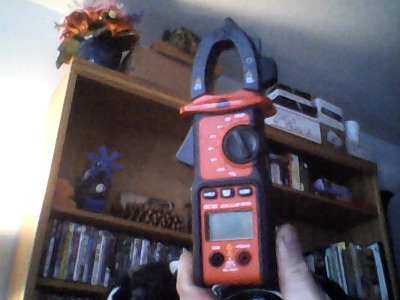A place to discuss hardware/software and diagnostic procedures
High amp clamp question
- brian.fuger
-
 Topic Author
Topic Author
- Offline
- New Member
-

Less
More
- Posts: 3
- Thank you received: 0
2 years 1 month ago - 2 years 1 month ago #63555
by brian.fuger
High amp clamp question was created by brian.fuger
Hey all,
I recently bought a EM720C high current amp clamp from a reputable tool dealer. I was wondering if I can use this with my oscillioscope. I use a Autel MP408 and I have a conversion test lead with banana plugs that I can hook up to the scope and new meter. Can I hook into the ports on the front of the meter and set it for current on the scope, or would I have to set the scope to read voltage? I'm trying to get better at using a scope, i'm trying to perform a relative compression test for practice. my test vehicle is a 2000 honda crv. I also have a low current clamp from same tool dealer that is 30A max. Thank you for everyones input and insight.
I recently bought a EM720C high current amp clamp from a reputable tool dealer. I was wondering if I can use this with my oscillioscope. I use a Autel MP408 and I have a conversion test lead with banana plugs that I can hook up to the scope and new meter. Can I hook into the ports on the front of the meter and set it for current on the scope, or would I have to set the scope to read voltage? I'm trying to get better at using a scope, i'm trying to perform a relative compression test for practice. my test vehicle is a 2000 honda crv. I also have a low current clamp from same tool dealer that is 30A max. Thank you for everyones input and insight.
Last edit: 2 years 1 month ago by brian.fuger. Reason: Change of title of post
Please Log in or Create an account to join the conversation.
- Noah
-

- Offline
- Moderator
-

- Give code definitions with numbers!
Less
More
- Posts: 4959
- Thank you received: 1111
2 years 1 month ago - 2 years 1 month ago #63563
by Noah
"Ground cannot be checked with a 10mm socket"
Replied by Noah on topic High amp clamp question
As far as I can tell, the clamp/meter combo tool cannot be used in combination with a scope or another meter.
You're stuck using the digital display on the tool.
This doesn't make it a bad tool, just not useful for capturing waveforms.
You're stuck using the digital display on the tool.
This doesn't make it a bad tool, just not useful for capturing waveforms.
"Ground cannot be checked with a 10mm socket"
Last edit: 2 years 1 month ago by Noah.
Please Log in or Create an account to join the conversation.
- brian.fuger
-
 Topic Author
Topic Author
- Offline
- New Member
-

Less
More
- Posts: 3
- Thank you received: 0
2 years 1 month ago #63564
by brian.fuger
Replied by brian.fuger on topic High amp clamp question
I came to the same conclusion last night. Well, I did need one for work, so that's a plus. Thank you for the feedback. I'll just have to save up for another high amp clamp.
Please Log in or Create an account to join the conversation.
- Chad
-

- Offline
- Moderator
-

- I am not a parts changer.
Less
More
- Posts: 2129
- Thank you received: 715
2 years 1 month ago - 2 years 1 month ago #63573
by Chad
"Knowledge is a weapon. Arm yourself, well, before going to do battle."
"Understanding a question is half an answer."
I have learned more by being wrong, than I have by being right.
Replied by Chad on topic High amp clamp question
Using an amp clamp is one way to do a relative compression test. Another way is to just scope the battery voltage.
Connect your scope test leads to battery Positive and Negative, Enable AC coupling and set the scope to a 2 volt scale.
As Current goes up, Voltage goes down. Because of this, the voltage waveform will be upside down, compared to an amperage waveform. If your scope has and invert function, turning it on will flip the voltage waveform over, to look just like the Amp Clamp waveform would look. If you do not have an invert function, reversing the scope leads at the battery will invert the waveform, too.
Connect your scope test leads to battery Positive and Negative, Enable AC coupling and set the scope to a 2 volt scale.
As Current goes up, Voltage goes down. Because of this, the voltage waveform will be upside down, compared to an amperage waveform. If your scope has and invert function, turning it on will flip the voltage waveform over, to look just like the Amp Clamp waveform would look. If you do not have an invert function, reversing the scope leads at the battery will invert the waveform, too.
"Knowledge is a weapon. Arm yourself, well, before going to do battle."
"Understanding a question is half an answer."
I have learned more by being wrong, than I have by being right.
Last edit: 2 years 1 month ago by Chad.
The following user(s) said Thank You: juergen.scholl
Please Log in or Create an account to join the conversation.
- juergen.scholl
-

- Offline
- Platinum Member
-

- Active partschanger
Less
More
- Posts: 1230
- Thank you received: 462
2 years 1 month ago #63578
by juergen.scholl
An expert is someone who knows each time more on each time less, until he finally knows absolutely everything about absolutely nothing.
Replied by juergen.scholl on topic High amp clamp question
Another way to measure RC is to connect the signal lead of one channel to the engine block and its ground lead to battery negative post. That way you can let the channel DC-coupled and you don't need to invert the trace. Peaks in the waveform correspond to compression peaks. You would use a 1volt scale for the entire screen.
An expert is someone who knows each time more on each time less, until he finally knows absolutely everything about absolutely nothing.
The following user(s) said Thank You: Noah, Chad
Please Log in or Create an account to join the conversation.
- oic5555
-
- Offline
- New Member
-

Less
More
- Posts: 18
- Thank you received: 11
2 years 1 month ago #63593
by oic5555
Replied by oic5555 on topic High amp clamp question
Hello,
You might check aeswave, they have current/amp clamps on black friday sale. They are offering the low and the high styles and they offer both bannana or bnc connections. They are priced better than the hanteks on amz. They are great to deal with.
You might check aeswave, they have current/amp clamps on black friday sale. They are offering the low and the high styles and they offer both bannana or bnc connections. They are priced better than the hanteks on amz. They are great to deal with.
The following user(s) said Thank You: Noah
Please Log in or Create an account to join the conversation.
Time to create page: 0.257 seconds


